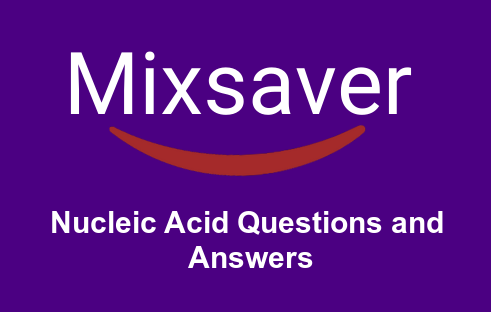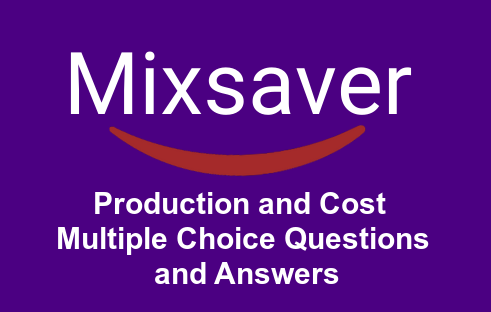Nucleic Acid MCQ | Protein Synthesis Questions and Answers PDF
1. Radioisotope used to label proteins differentially from nucleic acids is
( a ) 32P
( b ) 14C
( c ) 35S
( d ) 15N
Ans. c
2. Sugar – phosphate backbone in nucleic acid is
I. Hydrophilic in nature
II. Negatively charged
( a ) Only I
( b ) Only II
( c ) Both I and II
( d ) Neither I nor II
Ans. c
3. In a given nucleic acid G + A is not equal to C + T content This indicates sample is
( a ) DNA
( b ) ssDNA
( d ) GC rich
Ans. b
4. The information in a genetic nucleic acid resides in the
( a ) kinds of nucleotides
( b ) sequence of nucleotides
( c ) number of nucleotides
( d ) All of the above
Ans. d
5. Melting of DNA results in
( a ) increase in the optical density
( b ) decrease in the optical density
( c ) no change in the optical density
( d ) None of the above
Ans. a
6. DNA base stacking is diagnosed by
( a ) hyperchromacity
( b ) pH change
( c ) electrophoretic mobility
( d ) None of these
Ans. a
7. Melting temperature of DNA is the temperature at which
( a ) 50 % of the DNA is denatured
( b ) 80 % of the DNA is denatured
( c ) DNA melts completely
( d ) None of the above
Ans. a
8. Chargaff’s rule states that
( a ) A + G / T + C = 1
( b ) ( A + T ) / ( G + C ) = always 1
( c ) G = C in both RNA and DNA
( d ) In RNA , AU and in DNA , A = T
Ans. a
9. Which reagents and conditions denature dsDNA ?
I. Heat
II . Extreme pH
III . Urea
IV . Ethanol
( a ) Only I
( b ) I , II and III
( c ) I, II , III and IV
( d ) IV and I
Ans. c
10. GC rich DNA has higher stability than AT rich DNA because
( a ) stacking interactions are stronger in GC bp
( b ) GC base pairs bind the double helix more tightly
( c ) fewer Nations bind to AT bp
( d ) GC base pairs have three hydrogen bonds
Ans. d
MCQ on Nucleic Acid
11. Double – stranded DNA molecule uses its viscosity upon
( a ) denaturation
( b ) filtration
( c ) sedimentation
( d ) concentration
Ans. a
12. Each unit of a nucleic acid consisting of a sugar , attached phosphate group and base is a
( a ) nucleolus
( b ) nucleotide
( c ) histone
( d ) nucleosome
Ans. b
13. In nucleic acids , the phosphate group is attached to which carbon of the sugar ?
( a ) 5′
( d ) 4′
( c ) 3′
( d ) 2′
Ans. a
14. Nucleoside is a pyrimidine or purine base
( a ) covalently bonded to sugar
( b ) lonically bonded to a sugar
( c ) hydrogen bonded to a sugar
( d ) None of the above
Ans. a
15. Nucleic acids can be analysed experimentally by their
( a ) molecular weight
( b ) absorption of visible light
( c ) absorption of UV light
( d ) None of the above
Ans. c
16. A genetic unit that codes for amino acid sequence of a complete functional polypeptide could be termed as
( a ) cistron
( b ) exon
( c ) intron
( d ) recon
Ans. a
17. Which of the following is not necessary for protein synthesis to occur , once transcription is completed ?
( a ) tRNA
( b ) Ribosomes
( c ) mRNA
( d ) DNA
Ans. d
18. GTP is required by which of the following steps in protein synthesis ?
( a ) Attachment of mRNA to ribosomes
( b ) Translocation of RNA – nascent protein complex from A to P – sites
( c ) Attachment of ribosomes to endoplasmic reticulum
( d ) Aminoacyl RNA synthetase activation of amino acids
Ans. b
19. GUG codes for valine in both prokaryotes and eukaryotes but when its an initiation codon , it codes for
( a ) valine
( b ) tryptophan
( c ) methionine
( d ) None of these
Ans. c
20. Initiation of protein synthesis from most eukaryotic mRNA requires
( a ) a 5 ‘ cap
( b ) a 3′ poly A tail
( c ) a 3 ‘ cap
( d ) Both a poly A tail and a 5 cap
Ans. d
Protein Synthesis Multiple Choice Questions PDF
21. The growing polypeptide chain is released from the ribosomes when
( a ) a chain terminating codon is reached
( b ) a chain terminating RNA binds to the ribosome
( c ) the 7 – methyl guanosine cap is reached
( d ) the poly A tail is reached
Ans. a
22. The peptidyl transferase reaction occurs
( a ) on the large subunit
( b ) on the small subunit
( c ) between the subunit
( d ) None of these
Ans. a
23. The pathway of a RNA during polypeptide elongation on the ribosome is
( a ) A – site — P site —Ext site
( b ) A – site — P -site – Entry site
( c ) P – site — A site – Exit site
( d ) P – site — Entry site — Exit site
Ans. a
24. How many energy bonds are expended in the formation of a peptide bond ?
( a ) 3
( b ) 4
( c ) 2
( d ) 6
Ans. b
25. An antibiotic which inhibits translation in both prokaryotes and eukaryotes is
( a ) tetracycline
( b ) actinomycin – D
( C ) chloromycetin
( d ) puromycin
Ans. d
26. Wobble position means
( a ) base pairing
( b ) altered base on code
( c ) third altered base on code
( d ) None of the above
Ans. c
27. If Meselson and Stahl’s experiment is continued for four generations in bacteria , the ratio of fourth generation would be 15N / 15N : 15N / 14N : 14N / 14N containing DNA in the
( a ) 1: 1 : 0
( b ) 1: 4 : 0
( c ) 0: 1 : 3
( d ) 0:1: 7
Ans. d
28. Which of the following is the smallest RNA ?
( a ) mRNA
( b ) RNA
( c ) Chromosomal RNA
( d ) Ribosomal RNA
Ans. b
29. The translation step in the process of protein synthesis is made by a charged form of
( a ) mRNA
( b ) RNA
( c ) IRNA
( d ) template DNA
Ans. c
30. Genetic material is
( a ) any nucleic acid
( b ) a nucleic acid made from a nucieic acid template that has been of is capable of being used as a template in replication
( c ) a nucleic acid that is capable of being used as a template in transcription
( d ) a nucleic acid that is capable of being used as a template in replication and transcription
Ans. d
Nucleic Acids Multiple Choice Questions and Answers pdf
31. RNA polymerase
( a ) is the protein responsible for the production on ribonucleotides
( b ) is the enzyme that creates hydrogen bonds between nucleotides on the DNA template strand and their complementary RNA nucleotides
( c ) is the enzyme that transcribes exons , but does not transcribe introns
( d ) begins transcription at a promoter sequence and moves along the template strand of DNA , elongating the RNA molecule in a 5 ‘ + 3 ‘ direction
Ans. d
32. Transfer RNA
( a ) forms hydrogen bonds between its codon and the anticodon of mRNA in the A – site of a ribosome
( b ) binds to its specific amino acid in the active site of an aminoacyl RNA synthetase
( c ) uses GTP as the energy source to bind its amino acid
( d ) is translated from mRNA
Ans. b
33. Which enzyme is responsible for the synthesis of rRNA ?
( a ) ANA replicase
( b ) RNA polymerase
( c ) Aminoacyl RNA synthetase
( d ) Ribosomal enzymes
Ans. b
34. A prokaryotic gene of 600 nucleotides long can code for a polypeptide chain of about how many amino acids ?
( a ) 100
( b ) 200
( c ) 300
( d ) 600
Ans. b
35. Which of the following is transcribed and then translated to form a protein product ?
( a ) Gene for RNA
( b ) Intron
( c ) Gene for a transcription factor
( d ) Leader and trailer
Ans. c
36. A prokaryotic gene typically has all of the following features except
( a ) a promoter
( b ) an operator
( c ) enhancers
( d ) structural gene
Ans. c
37. Experiments using N ( heavy nitrogen ) to confirm the semiconservative replication of DNA were carried out by
( a ) Meselson and Stahl
( b ) Hershey and Chase
( c ) Beadle and Tatum
( d ) Watson and Crick
Ans. a
38. RNA and DNA were artificially synthesised in vitro by
( a ) Ochoa and Nirenberg
( b ) Ochoa and Kornberg
( c ) Kornberg and Nirenberg
( d ) Nirenberg and Khorana
Ans. d
39. DNA is a polymer of nucleotides which are linked to each other by 3-5 ‘ phosphodiester bond . To prevent polymerisation of nucleotides , which of the following modifications would you choose ?
( a ) Replace purine with pyrimidines
( b ) Remove / Replace 3’OH group in deoxyribose
( c ) Remove / Replace 2 OH group with some other group in deoxyribose
( d ) Both ( b ) and ( c )
Ans. b
40. In order to enable a chemical to serve as a genetic material , it is essential that the chemical should be
( a ) able to duplicate itself
( b ) able to form itself into long spiral molecules
( c ) a compound of pyrimidines and purines
( d ) easily changed
Ans. a
Nucleic Acid Questions and Answers
41. During protein synthesis , amino acids recognise and get attached to tRNA with the help of
( a ) ribosomes , sigma and rho factors
( b ) mRNA owma ana hora
( c ) aminoacyl RNA synthetase
( d ) tRNA
Ans. c
42. Who among the following established that RNA is the genetic material ?
( a )Lederberg
( b ) Griffith
( c ) Nirenberg and Holley
( d ) Fraenkel Conrat
Ans. d
43. In E. coli , ‘ lac ‘ operon is induced by
( a ) Beta – galactosidase
( b ) lactose
( c ) ‘l’ gene
( d ) promoter gene
Ans. b
44. In an E. coli cell , according to the operon theory , an operator gene combines with
( a ) inducer gene to switch on structural gene transcription
( b ) regulator gene to ‘ switch of structural gene transcription
( c ) regulator protein to switch of structural gene transcription
( d ) regulator protein to switch on structural gene transcription
Ans. c
45. Which one of the following pairs is correctly matched ?
( a ) Frederick Griffith Discovered the phenomenon of transformation
( b ) Linus Pauling Isolated DNA for the first time
( c ) Francis Crick Proposed one gene – one polypeptide hypothesis
( d ) George Beadle Proposed the concept of Inborn errors
Ans. a
Nucleotides and Nucleic Acids Exam Questions | MCQ on Nucleic Acid Metabolism | Aqa a Level Biology Nucleic Acids Exam Questions
46. When gene resemble functional genes , but do not produce functional substance are called
( a ) jumping gene
( b ) overlapping gene
( c ) pseudogene
( d ) non – functional gene
Ans. c
47. Which of the following will be translated into a protein ?
( a ) UAA AUG CCC TCC ATT ATG
( b ) AUG CCC UCU AUA GUA GTC
( c ) UAA CCC UCU AUA GUA GUC
( d ) AUG CCC UCU AUG GUC UAG
Ans. d
48. The example of inducible operon is
( a ) trp operon
( b ) lac operon
( c ) Both ( a ) and ( b )
( d ) None of these
Ans. b
49. In the absence of B – galactosidase , transcription of
( a ) lac – A is not possible
( b ) lac – Y is not possible
( c ) lac – Z is not possible
( d ) All of these
Ans. c
50. Expression of gene is controlled in eukaryotes
( a ) at one place in the nucleus
( b ) af many places in the nucleus
( c ) at many places in the cell
( d ) cannot be controlled at all
Ans. c
51. The histone protein associated with nucleic acid are
( a ) acidic in nature
( b ) basic in nature
( c ) amphoteric in nature
( d ) None of the above
Ans. b
52. In DNA if 10 % of guanine is present , how much thymine is present ?
( a ) 10 %
( b ) 20 %
( c ) 4095
( d ) 80 %
Ans. c
53. The length of DNA having 23 base pair is
( a ) 78 A
( b ) 78.4 A
( c ) 78.2 A
( d ) 74.2 A
Ans. c
54. A given double – stranded DNA molecule is 1,00,000 base pair long . The length of this DNA molecule will be
( a ) 104 nm
( b ) 10000 nm
( c ) 3.4 x 10 nm
( d ) 2,00.000 nm
Ans. c
55. There are special proteins that help to open up DNA double helix in front of the replication fork . These proteins are
( a ) DNA ligase
( b ) DNA polymerase
( c ) Endonuclease
( d ) DNA gyrase
Ans. d





